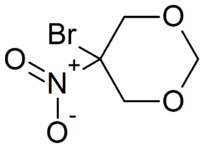Bronidox
 | |
| Names | |
|---|---|
| IUPAC name
5-Bromo-5-nitro-1,3-dioxane | |
| Other names
5-Bromo-5-nitro-m-dioxane | |
| Identifiers | |
| 30007-47-7 | |
| 3D model (Jmol) | Interactive image |
| ChemSpider | 1741 |
| ECHA InfoCard | 100.045.441 |
| EC Number | 250-001-7 |
| PubChem | 1807 |
| UNII | U184I9QBNM |
| |
| |
| Properties | |
| C4H6BrNO4 | |
| Molar mass | 212.00 g·mol−1 |
| Appearance | White crystalline powder |
| Melting point | 60 °C (140 °F; 333 K)[1] 58.5−62 °C[2] |
| insoluble | |
| Hazards | |
| Main hazards | Toxic |
| R-phrases | R22 R38 |
| S-phrases | S36 |
| Lethal dose or concentration (LD, LC): | |
| LD50 (median dose) |
590 mg/kg (mouse, oral) 455 mg/kg (rat, oral) 31 mg/kg (rat, ipr.) 2500 µg (mouse, skin) 2500 µg (rat, skin) |
| Except where otherwise noted, data are given for materials in their standard state (at 25 °C [77 °F], 100 kPa). | |
| | |
| Infobox references | |
Bronidox, or 5-bromo-5-nitro-1,3-dioxane, is an antimicrobial chemical compound.
Bronidox causes inhibition of enzyme activity in bacteria.[3]
Bronidox is corrosive to metals.[4]
Uses
- Bactericide
- Fungicide, effective against yeast and other fungi
- It is used in immunology for preserving antibodies and antisera in 0.1 - 0.5% concentration. It is used as preservative to avoid use of sodium azide.
- Stabilizer
- Surfactant
- Used in cosmetics since the mid-1970s as preservative for shampoos, foam bath, etc. Maximum concentration is 0.1%.
- Some users do not recommend use in preparations destined for in vivo or tissue culture work[5]
See also
References
- ↑ 5-BROMO-5-NITRO-1,3-DIOXANE, chemicalland21.com
- ↑ "Archived copy" (PDF). Archived from the original (PDF) on September 29, 2007. Retrieved March 19, 2006.
- ↑ Ghannoum M, Thomson M, Bowman W, Al-Khalil S (1986). "Mode of action of the antimicrobial compound 5-bromo-5-nitro-1,3-dioxane (bronidox)". Folia Microbiol. (Praha). 31 (1): 19–31. doi:10.1007/BF02928676. PMID 3082729.
- ↑ http://www.products.cognis.com/COGNIS/prodleaf.nsf/(SBU_Catalog)/FFAD30C61B67EFEB41256B4100427DD1/$File/BRONIDOX_r_L_5_E.pdf
- ↑ Archived December 21, 2004, at the Wayback Machine.
This article is issued from Wikipedia - version of the 11/17/2016. The text is available under the Creative Commons Attribution/Share Alike but additional terms may apply for the media files.